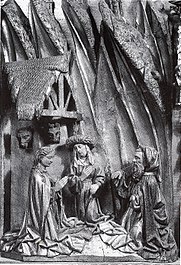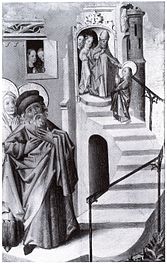Marienretabel (vineyards)
The Marienretabel was formerly in the Marienkirche in Rieden , today the municipality of Rosengarten (district of Schwäbisch Hall) . It was created around 1440–1450 by the master named after him from Rieden in Brussels or Leuven . More recent sources assume it was built around 1441. The panels on the altar were made by a Dutch painter.
The retable has been in the Württemberg State Museum in Stuttgart since 1877 .
history
The Marienretabel was the original high altar in the choir of the church in Rieden. In 1510 it was moved to the center of the church and in 1721 to the left side altar, where it stood at the end of the nave north of the triumphal arch. It stood there until the gallery was built in 1841. Then the work was moved to the north wall of the choir, where it was attached to the choir wall. In this state, the work of art was described in almost the same wording by Heinrich Merz , Jakob August Lorent and Julius Hausser in the 19th century .
On January 12, 1877, the Royal Museum of Patriotic Antiquities in Stuttgart, today's Württemberg State Museum , acquired the altar, for which the parish of Rieden received the purchase price of 400 marks.
description
Open state
Center shrine
The retable is 136 cm high and 235 cm wide when open. The rectangular shrine is made of oak and shows in high relief carved groups of figures made of walnut wood. The group of figures in the middle part of the shrine represents the birth of Christ in front of a rocky landscape . On the right, the shrine shows the adoration of the kings , and in the left part the marriage of Mary . What is remarkable, according to Wolfgang Deutsch, is the “character head of Josef. The simplicity of the presentation leads to great urgency. "
- Marian retable
Pull-out leaf insides
These show paintings, the left wing Saint Catherine of Alexandria with a crown, wheel and sword and the right wing Saint Barbara with a tower and palm branch. According to Wolfgang Deutsch, Katharina and Barbara are among the “virgines capitales”, the main virgin saints. They are subordinate to Mary as Queen of the Virgins ("Regina virginum"). They belonged to the Marian program of the Marian retable because the entire altarpiece was used to adore the Virgin.
- Pull-out leaf insides
Inside of the altar wings
These show paintings. The left wing of the altar shows the passage to the temple of Mary , the right wing of the altar shows Jesus :
The painting of Mary's temple passage shows the three-year-old Mary in a blue robe and red shoes as she goes up the stairs to the temple praying. At the temple portal she is received by the high priest dressed like a bishop . The clergyman is accompanied by two temple maidens. Two other temple maidens look out of a window. Below the stairs, on the left side of the picture, are Joachim and Anna . At the foot of the stairs there are lilies of the valley. Particularly noteworthy is "Joachim's sorrow, who speaks with his eyes and gestures".
The painting Representation of Jesus is connected with the theme of Mary, because this also represents a ritual purification of Mary according to Jewish regulations (in Luke's Gospel : Lk 2,22-40 EU ). The painting shows the processional candles and the doves as offerings for cleaning in a striking way. Through a double arch with a hanging keystone, we see the plain interior of a room with a tiled floor, wooden ceiling and arched window, a temple that is identified by a figure of Moses standing on the keystone and holding the tablets of the law. A late Gothic table in the middle of the room is supposed to represent the altar . To the left of the table is Maria with two other girls who are handing the child over to Simeon . In the painting, all temple visitors carry burning candles, which is a reference to the light procession on the feast of Mary's Purification, Candlemas . Also striking are the bluish-white discs that stick to the shaft of these candles. The portrayal of Simeon is particularly noteworthy - “the inner movement of Simeon, his devotion, which is expressed in the bending of the body, and in general the expressiveness of the gestures despite the summary reproduction of the fingers and hands. Look at how gently and lovingly Simeon's hands embrace the child. "
- Inside of the altar wings
Closed state
Extension sash outer sides
The outside of the extension wing has " Christ blesses the crowned Mary " as a theme. What is shown is not the coronation of the Mother of God herself, but the moment afterwards when Christ blesses the crowned woman. The “Glorification of Mary” is the theme on the inside of the extension wing. The left wing shows the crowned Mary. She is dressed in blue with her hair loose, equipped with a nimbus and crown (damaged) as "Queen of Heaven and Companion to the Throne of Christ". On the right table is Christ in white robes, holding the globe with his left hand on his lap, with his right hand he blesses Mary.
- Extension sash outer sides
Altar wing outer sides
These show paintings. The left wing of the altar shows the angel Gabriel and Mary on the right wing. The painting shows the archangel holding a long scepter in his right hand. In the left he holds a banner: “Ave Maria, gratia plena, Dominus tecum. Benedicta do in mulieribus ”. They are the words from Luke 1:28 ("Greetings, you who are favored, the Lord is with you, you are blessed among women".) Mary is represented with a halo and hair loose. She stands and reads deeply in a book. In front of her is a vase with a blooming lily, symbolizing her virginal purity. A banner can be seen around the nimbus: “Ecce ancilla Domini. Fiat mihi secundum verbum tuum, amen ”. These are words from Luke 1, 38 ("See I am the handmaid of the Lord, it shall be done to me according to your word, it shall be done".)
- Altar wing outer sides
Predella
The predella is 85 cm × 113 cm and shows the Lord's Supper as a relief . It does not originally belong to the reredos, but was created by another carver. It may be the same artist who carved the Last Supper in the sacristy and the predella of the Holy Spirit altar in Schwäbisch Hall.
- Predella
Predella wings
Originally the predella had wings with reliefs. Heinrich Merz wrote about it in 1845
"[...] on the wings on both sides two holy women, indelibly colored but not without expression and feeling"
Julius Baum notes in the 1917 catalog:
"[...] the painted wings ... on the outside female saints also on the inside individual figures under which only the Redeemer can be recognized in 1877, depicting no longer exist"
literature
- Eugen Gradmann : The art and antiquity monuments of the city and the Oberamt Schwäbisch-Hall . Paul Neff Verlag, Esslingen a. N. 1907, OCLC 31518382 , pp. 106-107 ( archive.org ).
- Wolfgang Deutsch: The oldest Riedener altar . In: Uta Friederich-Keitel, Rainer Keitel (ed.): Rieden im Rosengarten 1290–1990. Rieden 1990, pp. 67-102.
- Jörg Lusin: Rieden lost its high altar to the museum. In: Carlheinz Gräter, Jörg Lusin, Rainer Fieselmann: Churches, monasteries and chapels in Hohenlohe. History and stories. Silberburg-Verlag, Tübingen 2007, p. 18ff.
Individual evidence
- ^ Riedener Altar :: Landesmuseum Württemberg :: Resource :: museum-digital: Baden-Württemberg. Retrieved August 16, 2019 .
- ↑ Ignace Vandevivere: Un retable sculpté bruexellois du second tiers du XVe siècle au Musée de la "Quinta das Cruzes" de Funchal. In: Revue des archéologues et historiens d'art de Louvain 5, 1972, pp. 67–80; Hans MJ Nieuwdorp: Het huwelijk van de H. Maagd ': een Brussels retabelfragment uit het midden van de XVe eeuw. In: Bulletin des Musées Royaux des Beaux-Arts de Belgique 20, 1971 (1974), pp. 7-24. German 1985, here p. 163ff. with source citations in the notes and Deutsch 1990, pp. 88–91 assigns the altar to a carver from Löwen, with Deutsch dating the time of origin to the 1420 / 1430s and seeing Dutch models for the reliefs of the Riedener altar, according to Robert Campin.
- ↑ a b Riedener Altar :: Landesmuseum Württemberg :: museum-digital: Baden-Württemberg. Retrieved August 16, 2019 .
- ^ Alfred Stange: German Gothic painting. Vol. 8: Swabia in the period from 1450 to 1500. Deutscher Kunstverlag, Munich, Berlin 1957, pp. 112–113. Stange classifies it as a preliminary stage for Geertgen tot Sint Jans around 1440-50. Deutsch 1990, p. 89 the echoes of Geertgen do not seem compelling.
- ^ Stuttgart, Württembergisches Landesmuseum Inv. 6651. Julius Baum: German sculptures from the 10th to 18th centuries (= catalogs of the Royal Collection of Antiquities in Stuttgart , vol. 3), Stuttgart / Berlin 1917, pp. 268–271, no. 323, plates 18–19.
- ↑ German 1990, p. 91.
- ↑ German 1990, p. 91.
- ↑ German 1990, p. 95.
- ↑ German 1990, p. 95.
- ^ Heinrich Merz: Walk through the most distinguished churches in Württemberg. In: Evangelisches Kirchenblatt first for Württemberg 6, 1845, p. 580; Jakob August Lorent: Monuments of the Middle Ages in the Kingdom of Württemberg , II. Department, Mannheim 1867, pp. 191–192; Julius Hausser: Schwäbisch Hall and its surroundings , Hall 1877, p. 120.
- ↑ German 1990, pp. 96-97.
- ↑ German 1990, p. 90.
- ↑ German 1990, p. 84.
- ↑ Deutsch (1990), p. 75.
- ↑ Deutsch (1990), p. 90.
- ↑ Deutsch (1990), pp. 79-80.
- ↑ Deutsch (1990), p. 90.
- ↑ a b c Deutsch (1990), p. 81.
- ↑ German 1990, p. 84.
- ↑ German 1990, p. 84.
- ^ Stuttgart, Württembergisches Landesmuseum Inv. 6655. Julius Baum: German sculptures from the 10th to the 18th century (= catalogs of the Royal Collection of Antiquities in Stuttgart , Vol. 3), Stuttgart / Berlin 1917, p. 280 No. 332.
- ^ Heinrich Merz: Walk through the most distinguished churches in Württemberg. In: Evangelisches Kirchenblatt first for Württemberg 6, 1845, p. 261 ff., Here p. 580.
- ↑ Julius Baum: Deutsche Bildwerke des 10th to 18th centuries (= catalogs of the Royal Collection of Antiquities in Stuttgart , Vol. 3), Stuttgart / Berlin 1917, p. 280 No. 323.












